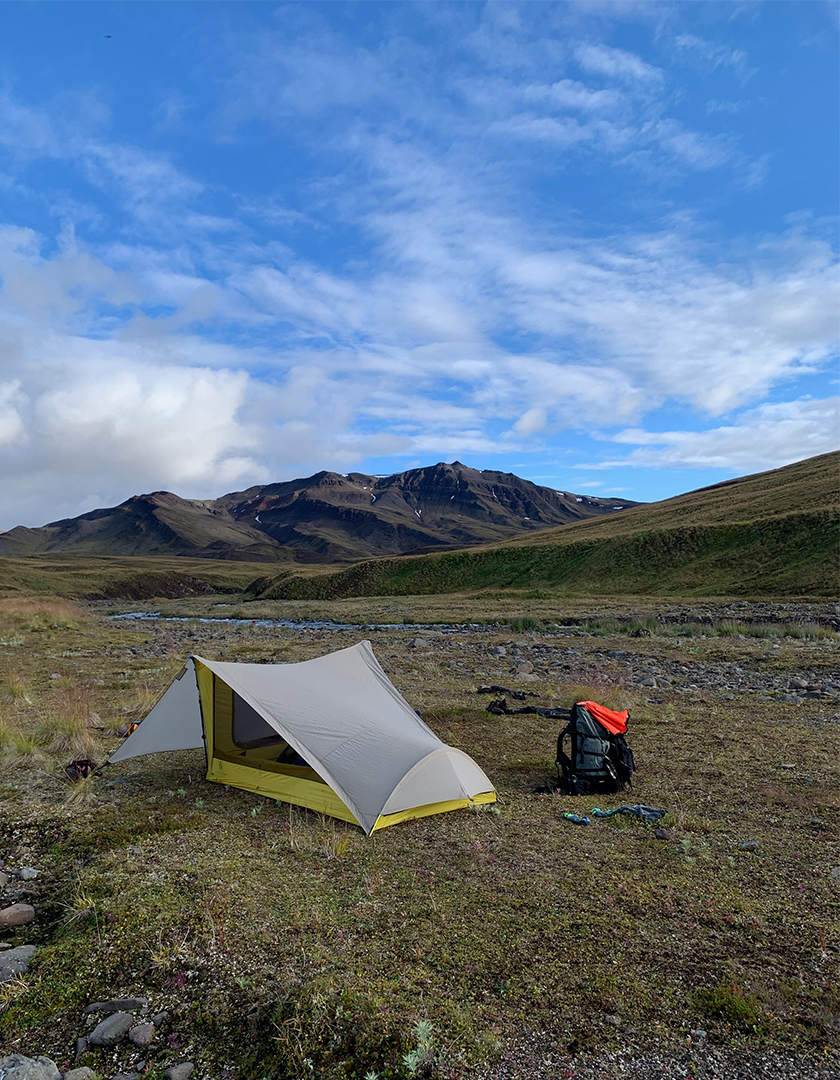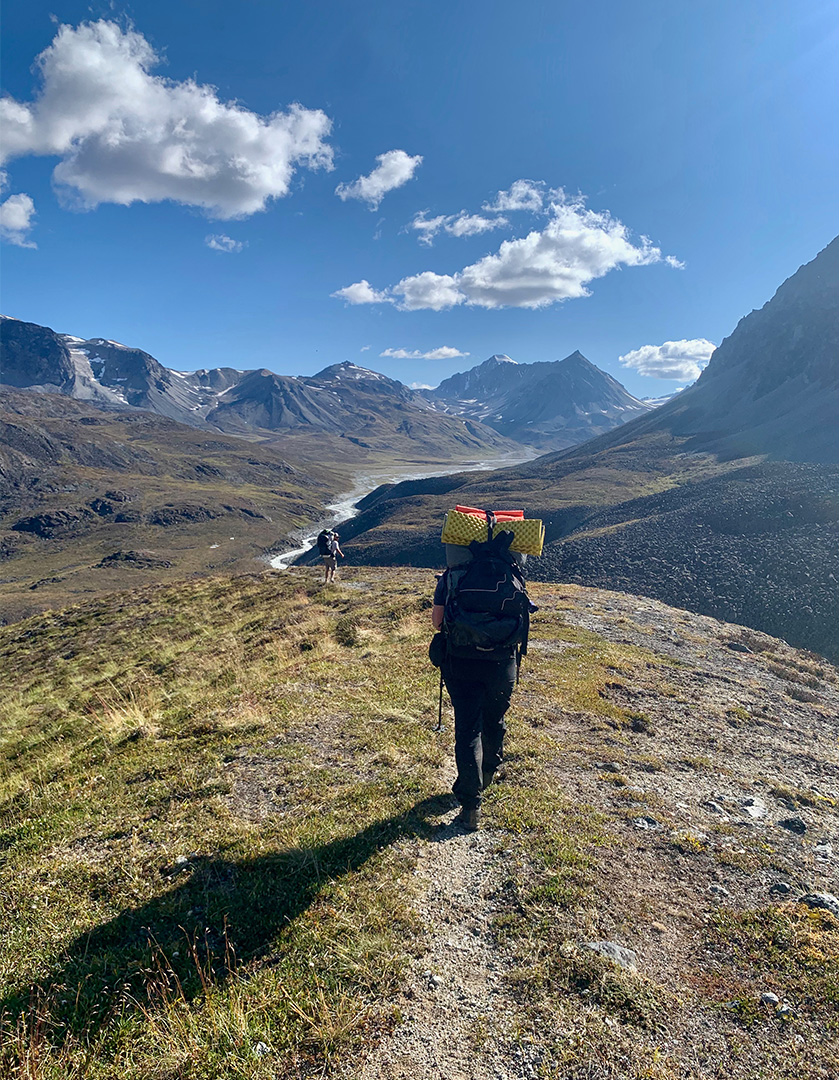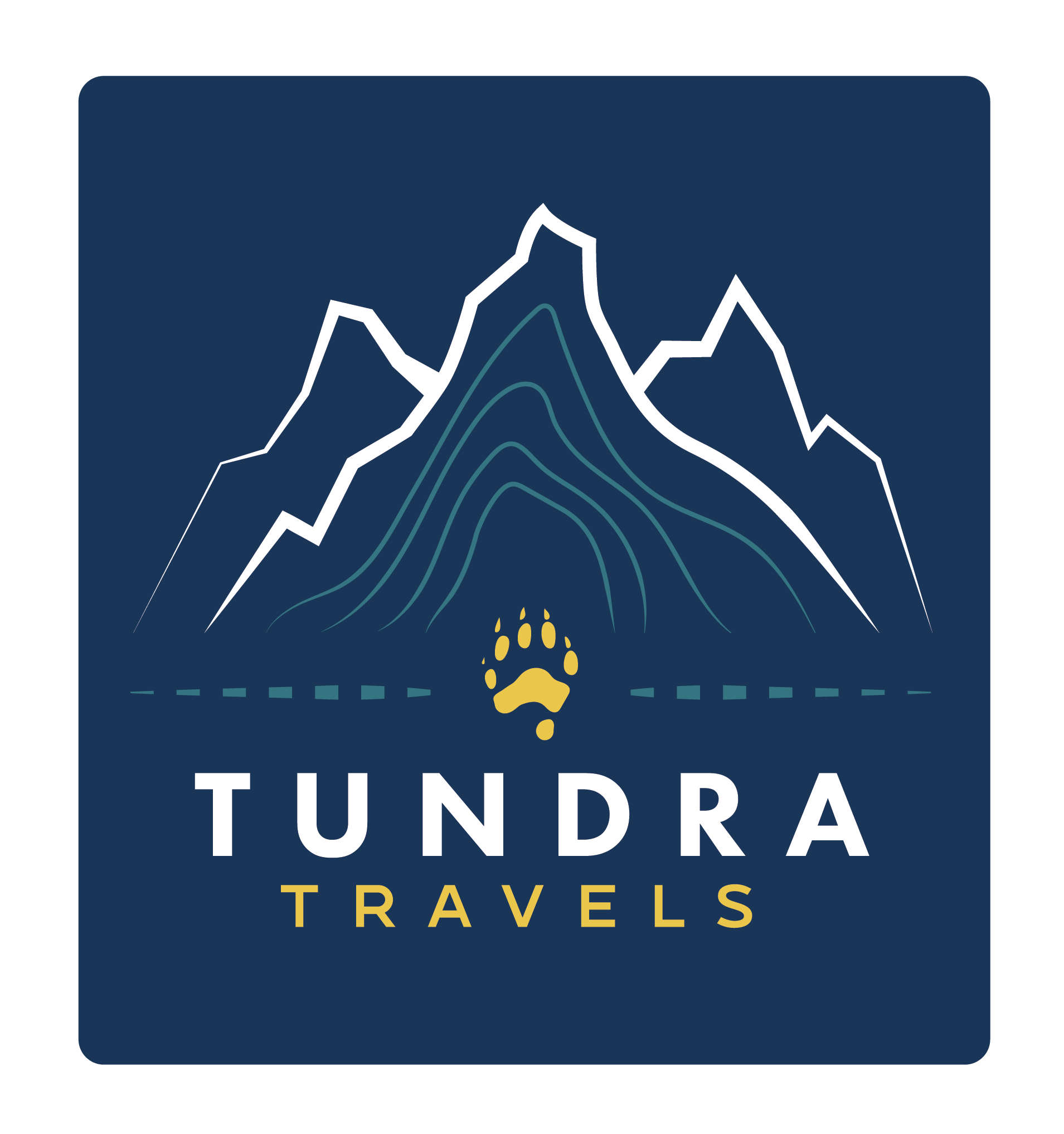22 Jan Getting Ready Pt 1 – Equipment for Adventure
WHETHER YOU ARE JOINING US ON A TUNDRA TRAVELS TRIP IN BACKCOUNTRY ALASKA, OR YOU’RE HERE DOING RESEARCH FOR AN INDEPENDENT BACKPACKING ADVENTURE, WE’RE STOKED TO HELP YOU GET READY FOR THE TRIP OF A LIFETIME.

This is the first in a series of posts on getting ready for a trip in backcountry Alaska. We are starting with gear because when your gear is dialed and you’ve brought the right things, it elevates a backcountry trip and you can focus on everything else. When your gear is disorderly, insufficient or superfluous – you’ll notice it, you’ll regret it and it will detract from the adventure. In the worst case scenario, bringing the wrong equipment can be truly dangerous – leading to pain, discomfort, hypothermia or worse.
Our next post in this series focuses on physical fitness and pre-trip training, because the more functionally fit you are, the more fun you’ll have. Stay tuned

I’ve spent over a decade perfecting my Alaskan backpacking kit. Packing for a backpacking trip in Alaska can be tough – you need to be prepared for temperatures between 40-75F, sun, rain, wind and everything in between. You need to bring enough to be comfortable, but not so much you’re weighed down by extra weight. You’ll notice that for most items, I only recommend you bring one – as in one t-shirt, one pair of pants, etc. Yes, they will smell by the end of the trip, but that is far preferable to lugging around things you don’t need or don’t use. We’ve put together a Personal Equipment Checklist for our guests, shown below. But it is also available to view and download for anybody looking to get ready for an Alaskan backcountry trip. So whether you are joining us for a trip or not, I hope this list helps you prepare for your next adventure!
Keep in mind that the items on this list, excluding those in the “optional” section are all mandatory for our Tundra Travels guests. We’ll do a thorough gear check prior to your departure to make sure you have sufficient clothing and equipment. While the items are mandatory, the individual recommendations of brands and models are not – these are just what we have found to work especially well, hold up to heavy use and, in most cases, are moderately affordable. We don’t make any money from these links or have any agreements with these companies, these are just products we love. In all scenarios, the best gear and clothing for you are the items that fit your body, feel comfortable and work within your budget. If you have questions about any of these items, you can always contact us.
PERSONAL EQUIPMENT CHECKLIST
GEAR AND EQUIPMENT
- Tent – If you have a backpacking tent you like that does well in potentially heavy wind and rain, you’re welcome to bring your own tent. If not, we have sturdy, lightweight tents available to rent.
- Backpack – The best backpack is one that fits you and you are sure can comfortably carry the weight required. If you’re interested in a lightweight option, we love the 4400 and 5400 cu in packs from Hyperlite Mountain Gear
- Waterproof backpack cover – If your pack is not waterproof, you’ll need a waterproof backpack cover. Make sure the cover is large enough to fit over your fully loaded pack. Dirtbag alternative – line your backpack with one or two trash compactor bags.
- Trekking poles – Seriously. Even if you’ve never used trekking poles before, you will definitely want them for off-trail, backpacking in Alaska. If you don’t have or want to purchase a pair, we have poles available to rent.
- Waterproof compression sacks (2) – Bring one for your sleeping bag and one for your clothing. We recommend the Sea to Summit Ultra-Sil eVent Compression Dry Sack.
- Sleeping bag – You need a compressible, lightweight sleeping bag rated 20-30F. Don’t waste half the space in your backpack on an oversized bag. We have high quality, warm bags available to rent. We love the bags from Western Mountaineering. They’re pricey, but in this case you very much get what you pay for.
- Sleeping pad – You want a compressible, lightweight sleeping pad. If you prefer, we have our favorite model the Thermarest Neoair Xlite, available to rent.
- Camp chair – Leisurely mornings and evenings under the cook tarp are one of the best parts of our trips, and they are much more comfortable with a camp chair. Those tripod models are cute but not very compatible with our tarps or the backcountry’s uneven surfaces. We recommend a lightweight Crazy Creek Hex 2.0 and have them available to rent.
- Headlamp – Not necessary for a trip in June or July, but if you’re joining us in August, bring one. We like the Petzl Bindi Ultralight Headlamp. Whatever model you choose, make sure to look for one with a lock function.
- Water bottle/hydration bladder – You can’t go wrong with a wide mouth, 1L Nalgene, but if you insist on bringing a hydration bladder instead, be sure it works with your backpack.
- Camp bowl and eating utensil – Bring your favorite lightweight option. Or rent one of ours.
FEET AND HANDS
- Hiking boots or sturdy trail shoes – The best hiking boots or shoes are the ones that fit you. Word of warning, if you prefer trail shoes over hiking boots – tussocks were made to destroy ankles. Only opt for hiking shoes if you are sure that you can backpack off-trail in them.
- Camp shoes – We bring Croc Clogs on every trip – they’re waterproof and closed-toed, perfect for walking around camp on a rainy night.
- Sleep socks – Bring one warm, loose pair of socks just for sleeping. Dry feet at night can’t be beat!
- Hiking socks – We usually bring three pairs. Test them out with your hiking boots beforehand.
- Gloves – Bring two pairs – one lightweight pair for cold days hiking and another, slightly warmer pair for around camp.
CLOTHING
- Underwear/bras – This feels like a personal decision… But, we usually bring one bra and 3(ish) pairs of underwear for a 7-10 day trip.
- Shorts and/or pants – If you “run warm”, you might prefer to hike in shorts, especially on a sunny day in Alaska’s arctic. But low vegetation can leave you with scraped and scratched legs if you opt for shorts. Most folks prefer/are comfortable with hiking in pants regardless of the temperature – it never really gets that hot in Alaska.
- T-shirt – Pretty straightforward. Bring a non-cotton, lightweight t-shirt.
- Long underwear – Great for wearing under your hiking pants on cold days. You’ll also use them for sleeping and hanging in camp. We like the Patagonia Capilene Midweight Bottoms.
- Long-sleeve, upper-body insulated layer – We love the Firn Line Long Sleeve Merino Wool by Alpine Fit – extra points for this one since they are a woman-owned and Alaskan made company!
OUTERWEAR
- Wind shirt – This is a great in-between layer for when it is cool and breezy, but you don’t need a rain jacket.
- Puffy jacket – We love the Arc’teryx Proton Lt Hoody. Whatever model you choose, we recommend a synthetic option just in case we find ourselves in very damp conditions.
- Rain jacket – We wear the Arc’teryx Alpha AR Jacket. Yes, it is very pricey. But this is our job, we are out in the elements all the time and Alaska can be rainy AF. Whatever rain jacket you choose, look for GORE-TEX® fabric. Do not be seduced by ultralight rain jackets – they are fine for intermittent rain showers in the Rockies. In Alaska, they’ll leave you wet and maybe even hypothermic.
- Rain pants – Yes. You really need to bring rain pants. We know you may be buying them just for this trip, but should the weather not care about our hopes and dreams and unleash a multi-day deluge, you will need them. Look for something with a half to full side-zip to make it easier to put them on over boots. The OR Aspire GORE-TEX® Pants are a nice moderately priced option.
HEADWEAR
- Beanie – Bring a hat that is lightweight, compact and covers your ears.
- Bug net – Especially for those that are insect-sensitive, a head net can make the difference between a pleasant evening relaxing under the cook tarp and having to retreat to the tent to evade the marauding mosquitos.
- Ball cap – Go for something breathable and quick drying. Or your hat that looks best in photos. You do you.
- Neck gaiter – We love the Geo Neck Gaiter by Alpine Fit.
ADDITIONAL ITEMS/TOILETRIES
- Entertainment – There is significant tent-time each evening in camp. And there is always the possibility of truly terrible weather that keeps us tent-bound for part or all of a day. Bring one or two of the following: book, kindle, phone, camera, headphones, journal, deck of cards, bananagrams, etc.
- Sunglasses + case – Bring a hard-sided case to store your sunglasses, we can’t tell you how many pairs we’ve seen crushed inside backpacks.
- Personal medications – Bring enough for every day of your trip plus at least 2 days in case of weather delays.
- Small pack towel – For stream/lakeside baths.
- Sunscreen – One small container should be sufficient.
- Chapstick
- Toiletries – At a maximum we bring: small toothbrush, small container of toothpaste, a small comb, floss, a small bottle of biodegradable soap (we like Dr. Bronners) or small package of wet wipes and a small baggie of your personal pain reliever of choice (ibuprofen, acetaminophen, etc.)
OPTIONAL
- Insulated mug – We use our Nalgenes for all beverages, including coffee, tea, cocoa, etc. But if drinking water out of a coffee scented water bottle sounds unpalatable, consider bringing an insulated mug to enjoy your hot beverages. These are also available to rent.
- Binoculars – Optics are especially nice if you’re interested in birds. But there are usually a couple pairs in the group and if you don’t have a strong interest, avoid carrying the weight.
- Insect repellent – Especially for those that are insect-sensitive, bug spray can help make a backcountry trip in Alaska more enjoyable. Be advised that 100% deet can melt & damage GORE-TEX® clothing, use with caution.
- Additional dry bag(s) – One or two additional dry bags can help to protect your items in the event of inclement weather, especially if you’re bringing electronics.
- Charing device – If you’re bringing a camera, phone or kindle that may require recharging, bring a battery charging device and the appropriate cords. Small solar panels may work, but are less dependable in rainy or overcast conditions. We carry a Goal Zero Flip 36 Power Bank. There are lots of other good options out there.
- Waterproof gaiters – Nice for protecting shins and keeping feet dry(ish) on stream crossings and rainy days.
- Heavyweight, synthetic or fleece pants and top – If you “run cold” these additional layers will help you sleep better and enjoy time in camp. If you “run warm” this could just be extra weight you carry..
In addition to the items on this list, we will be supplying some group gear items and your guide will be carrying additional group gear and safety items. So, if you’re using this list to plan a personal adventure, make sure to add the following items to your checklist:
ITEMS YOUR GUIDE WILL CARRY
- Paper maps + compass – The old classic! Paper maps never run out of batteries! Plus they’re fun to look at each night in camp to visually track your progress.
- Digital navigation – While we’ll always love paper maps, digital navigation has some undeniable benefits. We use GaiaGPS to navigate while in the backcountry.
- First aid kit
- Repair kit
- Stove(s)
- Emergency communication device – We carry either a satellite phone, a Garmin inReach text communication device, or both, depending on our destination.
- Communal eating tarp/shelter
- Water filtration/treatment
- Bear deterrents – Your guide(s) will always carry a bear spray. Depending on the destination, they may also carry bear bangers, flares, or in rare circumstances, a firearm.
ITEMS WE’LL GIVE TO YOU TO CARRY:
- Backcountry food – We bring enough food to eat hearty breakfasts and dinners each day with lots of snacking in between. We also carry two meals worth of less opulent fare in case we are delayed in the backcountry for any reason.
- Bear resistant food container(s) – You’ll be issued one to two Ursacks to carry your meals and food. We’ve found these to be the best bear resistant, packable and lightweight option available.
- Bear spray – Every guest on our trips is issued a personal canister of bear spray with a holster. You’ll be trained how to use it before we go into the backcountry.
- Fuel – While your guide(s) will carry the stove(s) for the group, fuel bottles will be shared amongst the group.



No Comments